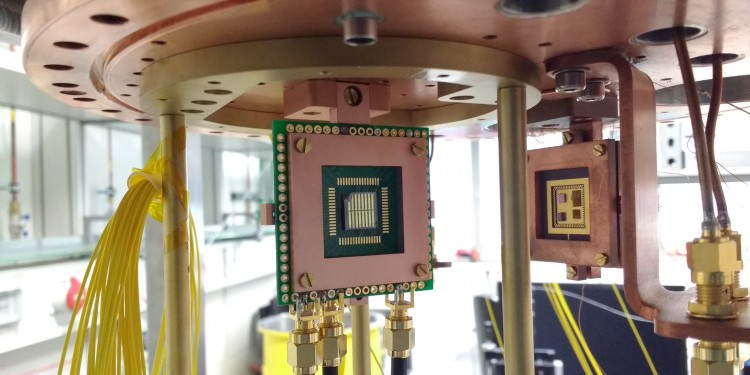Feb 11 2020
The aim of more and more research groups across the globe has been to build a quantum computer with the ability to solve problems that cannot be solved by classical computers, or can only be solved with considerable effort.
 Measurement setup for the characterization of microbridges in a cryostat. Image Credit: Martin Wolff.
Measurement setup for the characterization of microbridges in a cryostat. Image Credit: Martin Wolff.
This is because quantum effects that arise from the realm of the smallest particles and structures facilitate several new technological applications. The so-called superconductors, which enable processing of signals and information based on the laws of quantum mechanics, are regarded as potential components for achieving quantum computers.
However, one major drawback of superconducting nanostructures is that they can work only at extremely low temperatures, and so it is challenging using them for practical applications.
For the first time, at the University of Münster and Forschungszentrum Jülich, scientists have demonstrated that the so-called energy quantization in nanowires is formed of high-temperature superconductors—that is, superconductors in which the temperature is higher, but below which quantum mechanical effects are prevalent.
Then, the superconducting nanowire occupies only chosen energy states that could be used for information encoding. In the case of high-temperature superconductors, for the first time, the scientists could visualize how a single photon is absorbed. The photon is a light particle that transmits information.
On the one hand, our results can contribute to the use of considerably simplified cooling technology in quantum technologies in the future, and on the other hand, they offer us completely new insights into the processes governing superconducting states and their dynamics, which are still not understood.
Jun. Prof. Carsten Schuck, Study Leader, Institute of Physics, University of Münster
Thus, the study outcomes may hold good for developing new kinds of computer technology. The research has been reported in the Nature Communications journal.
Background and Methods
Superconductors developed using the elements yttrium, barium, copper oxide, and oxygen (YBCO for short) was used by the researchers to fabricate thin wires measuring a few nanometers. Physical dynamics known as phase slips arise when an electrical current is conducted by these structures. In the YBCO nanowires, changes in the supercurrent are brought about by fluctuations in the charge carrier density.
The processes that occur in the nanowires were analyzed by the team at temperatures <20 K, or −253 °C. They also used model calculations to demonstrate the quantization of the energy states in the nanowires. The wires entered the quantum state at a temperature of 12–13 K, which is several hundred times greater than that needed for the materials usually used.
Thus, the researchers were able to generate resonators, or oscillating systems adjusted to particular frequencies, with considerably longer lifetimes and to preserve the quantum mechanical states for a longer period. This is a precondition for the long-term creation of the largest-ever quantum computers.
Absorption of a Single Photon in High-Temperature Superconductors
Detectors with the ability to register even single photons are not only vital components for developing quantum technologies but possibly also for medical diagnostics. The research team of Carsten Schuck at the University of Münster has been attempting for a number of years to develop such superconductor-based single-photon detectors.
For more than 10 years, researchers across the globe have been attempting to realize, by using high-temperature superconductors, what is already possible at low temperatures. For the first time, this attempt has now become successful in the YBCO nanowires used for the research.
Our new findings pave the way for new experimentally verifiable theoretical descriptions and technological developments.
Martin Wolff, Study Co-Author, Schuck Research Group, University of Münster
Participating Institutions and Funding
The superconducting films developed at Forschungszentrum Jülich were nanostructured at the University of Münster and in Jülich. The experimental characterization of these films was performed at the University of Münster.
This study was funded by the Ministry of Economics, Innovation, Digitization and Energy of the State of North Rhine-Westphalia and the Ernst Ruska-Centre for Microscopy and Spectroscopy with Electrons (ER-C) of the Forschungszentrum Jülich.